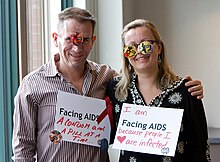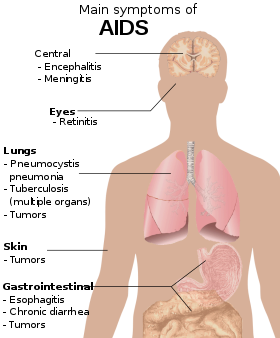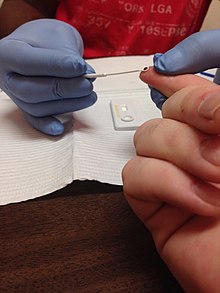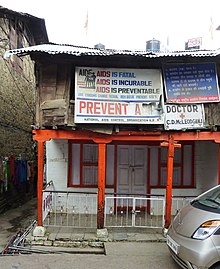Signs and symptoms
There are three main stages of HIV infection: acute infection, clinical latency, and AIDS.[1][24]
Acute infection
Owing to their nonspecific character, these symptoms are not often recognized as signs of HIV infection. Even cases that do get seen by a family doctor or a hospital are often misdiagnosed as one of the many common infectious diseases with overlapping symptoms. Thus, it is recommended that HIV be considered in people presenting with an unexplained fever who may have risk factors for the infection.[27]
Clinical latency
The initial symptoms are followed by a stage called clinical latency, asymptomatic HIV, or chronic HIV.[1] Without treatment, this second stage of the natural history of HIV infection can last from about three years[29] to over 20 years[30] (on average, about eight years).[31] While typically there are few or no symptoms at first, near the end of this stage many people experience fever, weight loss, gastrointestinal problems and muscle pains.[1] Between 50% and 70% of people also develop persistent generalized lymphadenopathy, characterized by unexplained, non-painful enlargement of more than one group of lymph nodes (other than in the groin) for over three to six months.[24]
Although most HIV-1 infected individuals have a detectable viral load and in the absence of treatment will eventually progress to AIDS, a small proportion (about 5%) retain high levels of CD4+ T cells (T helper cells) without antiretroviral therapy for more than five years.[27][32] These individuals are classified as “HIV controllers” or long-term nonprogressors (LTNP).[32] Another group consists of those who maintain a low or undetectable viral load without anti-retroviral treatment, known as “elite controllers” or “elite suppressors”. They represent approximately 1 in 300 infected persons.[33]
Acquired immunodeficiency syndrome
Opportunistic infections may be caused by bacteria, viruses, fungi, and parasites that are normally controlled by the immune system.[34] Which infections occur depends partly on what organisms are common in the person’s environment.[27] These infections may affect nearly every organ system.[35]
People with AIDS have an increased risk of developing various viral-induced cancers, including Kaposi’s sarcoma, Burkitt’s lymphoma, primary central nervous system lymphoma, and cervical cancer.[28] Kaposi’s sarcoma is the most common cancer, occurring in 10% to 20% of people with HIV.[36] The second-most common cancer is lymphoma, which is the cause of death of nearly 16% of people with AIDS and is the initial sign of AIDS in 3% to 4%.[36] Both these cancers are associated with human herpesvirus 8 (HHV-8).[36] Cervical cancer occurs more frequently in those with AIDS because of its association with human papillomavirus (HPV).[36] Conjunctival cancer (of the layer that lines the inner part of eyelids and the white part of the eye) is also more common in those with HIV.[37]
Additionally, people with AIDS frequently have systemic symptoms such as prolonged fevers, sweats (particularly at night), swollen lymph nodes, chills, weakness, and unintended weight loss.[38] Diarrhea is another common symptom, present in about 90% of people with AIDS.[39] They can also be affected by diverse psychiatric and neurological symptoms independent of opportunistic infections and cancers.[40]
Transmission
| Exposure route | Chance of infection | |||
|---|---|---|---|---|
| Blood transfusion | 90%[41] | |||
| Childbirth (to child) | 25%[42][clarification needed] | |||
| Needle-sharing injection drug use | 0.67%[43] | |||
| Percutaneous needle stick | 0.30%[44] | |||
| Receptive anal intercourse* | 0.04–3.0%[45] | |||
| Insertive anal intercourse* | 0.03%[46] | |||
| Receptive penile-vaginal intercourse* | 0.05–0.30%[45][47] | |||
| Insertive penile-vaginal intercourse* | 0.01–0.38%[45][47] | |||
| Receptive oral intercourse*§ | 0–0.04%[45] | |||
| Insertive oral intercourse*§ | 0–0.005%[48] | |||
| * assuming no condom use § source refers to oral intercourse performed on a man |
||||
HIV is spread by three main routes: sexual contact, significant exposure to infected body fluids or tissues, and from mother to child during pregnancy, delivery, or breastfeeding (known as vertical transmission).[13] There is no risk of acquiring HIV if exposed to feces, nasal secretions, saliva, sputum, sweat, tears, urine, or vomit unless these are contaminated with blood.[49] It is also possible to be co-infected by more than one strain of HIV—a condition known as HIV superinfection.[50]
Sexual
The most frequent mode of transmission of HIV is through sexual contact with an infected person.[13] However, an HIV-positive person who has an undetectable viral load as a result of long-term treatment has effectively no risk of transmitting HIV sexually.[51][52] The existence of functionally noncontagious HIV-positive people on antiretroviral therapy was controversially publicized in the 2008 Swiss Statement, and has since become accepted as medically sound.[53]
Globally, the most common mode of HIV transmission is via sexual contacts between people of the opposite sex;[13] however, the pattern of transmission varies among countries. As of 2017, most HIV transmission in the United States occurred among men who had sex with men (82% of new HIV diagnoses among males aged 13 and older and 70% of total new diagnoses).[54][55] In the US, gay and bisexual men aged 13 to 24 accounted for an estimated 92% of new HIV diagnoses among all men in their age group and 27% of new diagnoses among all gay and bisexual men.[56]
With regard to unprotected heterosexual contacts, estimates of the risk of HIV transmission per sexual act appear to be four to ten times higher in low-income countries than in high-income countries.[57] In low-income countries, the risk of female-to-male transmission is estimated as 0.38% per act, and of male-to-female transmission as 0.30% per act; the equivalent estimates for high-income countries are 0.04% per act for female-to-male transmission, and 0.08% per act for male-to-female transmission.[57] The risk of transmission from anal intercourse is especially high, estimated as 1.4–1.7% per act in both heterosexual and homosexual contacts.[57][58] While the risk of transmission from oral sex is relatively low, it is still present.[59] The risk from receiving oral sex has been described as “nearly nil”;[60] however, a few cases have been reported.[61] The per-act risk is estimated at 0–0.04% for receptive oral intercourse.[62] In settings involving prostitution in low-income countries, risk of female-to-male transmission has been estimated as 2.4% per act, and of male-to-female transmission as 0.05% per act.[57]
Risk of transmission increases in the presence of many sexually transmitted infections[63] and genital ulcers.[57] Genital ulcers appear to increase the risk approximately fivefold.[57] Other sexually transmitted infections, such as gonorrhea, chlamydia, trichomoniasis, and bacterial vaginosis, are associated with somewhat smaller increases in risk of transmission.[62]
The viral load of an infected person is an important risk factor in both sexual and mother-to-child transmission.[64] During the first 2.5 months of an HIV infection a person’s infectiousness is twelve times higher due to the high viral load associated with acute HIV.[62] If the person is in the late stages of infection, rates of transmission are approximately eightfold greater.[57]
Commercial sex workers (including those in pornography) have an increased likelihood of contracting HIV.[65][66] Rough sex can be a factor associated with an increased risk of transmission.[67] Sexual assault is also believed to carry an increased risk of HIV transmission as condoms are rarely worn, physical trauma to the vagina or rectum is likely, and there may be a greater risk of concurrent sexually transmitted infections.[68]
Body fluids
The second-most frequent mode of HIV transmission is via blood and blood products.[13] Blood-borne transmission can be through needle-sharing during intravenous drug use, needle-stick injury, transfusion of contaminated blood or blood product, or medical injections with unsterilized equipment. The risk from sharing a needle during drug injection is between 0.63% and 2.4% per act, with an average of 0.8%.[69] The risk of acquiring HIV from a needle stick from an HIV-infected person is estimated as 0.3% (about 1 in 333) per act and the risk following mucous membrane exposure to infected blood as 0.09% (about 1 in 1000) per act.[49] This risk may, however, be up to 5% if the introduced blood was from a person with a high viral load and the cut was deep.[70] In the United States intravenous drug users made up 12% of all new cases of HIV in 2009,[71] and in some areas more than 80% of people who inject drugs are HIV-positive.[13]
HIV is transmitted in about 90% of blood transfusions using infected blood.[41] In developed countries the risk of acquiring HIV from a blood transfusion is extremely low (less than one in half a million) where improved donor selection and HIV screening is performed;[13] for example, in the UK the risk is reported at one in five million[72] and in the United States it was one in 1.5 million in 2008.[73] In low-income countries, only half of transfusions may be appropriately screened (as of 2008),[74] and it is estimated that up to 15% of HIV infections in these areas come from transfusion of infected blood and blood products, representing between 5% and 10% of global infections.[13][75] It is possible to acquire HIV from organ and tissue transplantation, although this is rare because of screening.[76]
Unsafe medical injections play a role in HIV spread in sub-Saharan Africa. In 2007, between 12% and 17% of infections in this region were attributed to medical syringe use.[77] The World Health Organization estimates the risk of transmission as a result of a medical injection in Africa at 1.2%.[77] Risks are also associated with invasive procedures, assisted delivery, and dental care in this area of the world.[77]
People giving or receiving tattoos, piercings, and scarification are theoretically at risk of infection but no confirmed cases have been documented.[78] It is not possible for mosquitoes or other insects to transmit HIV.[79]
Mother-to-child
HIV can be transmitted from mother to child during pregnancy, during delivery, or through breast milk, resulting in the baby also contracting HIV.[80][13] As of 2008, vertical transmission accounted for about 90% of cases of HIV in children.[81] In the absence of treatment, the risk of transmission before or during birth is around 20%, and in those who also breastfeed 35%.[81] Treatment decreases this risk to less than 5%.[82]
Antiretrovirals when taken by either the mother or the baby decrease the risk of transmission in those who do breastfeed.[83] If blood contaminates food during pre-chewing it may pose a risk of transmission.[78] If a woman is untreated, two years of breastfeeding results in an HIV/AIDS risk in her baby of about 17%.[84] Due to the increased risk of death without breastfeeding in many areas in the developing world, the World Health Organization recommends either exclusive breastfeeding or the provision of safe formula.[84] All women known to be HIV-positive should be taking lifelong antiretroviral therapy.[84]
Diagnosis
| Blood test | Days |
|---|---|
| Antibody test (rapid test, ELISA 3rd gen) | 23–90 |
| Antibody and p24 antigen test (ELISA 4th gen) | 18–45 |
| PCR | 10–33 |
HIV/AIDS is diagnosed via laboratory testing and then staged based on the presence of certain signs or symptoms.[25] HIV screening is recommended by the United States Preventive Services Task Force for all people 15 years to 65 years of age, including all pregnant women.[109] Additionally, testing is recommended for those at high risk, which includes anyone diagnosed with a sexually transmitted illness.[28][109] In many areas of the world, a third of HIV carriers only discover they are infected at an advanced stage of the disease when AIDS or severe immunodeficiency has become apparent.[28]
HIV testing
Antibody tests in children younger than 18 months are typically inaccurate, due to the continued presence of maternal antibodies.[110] Thus HIV infection can only be diagnosed by PCR testing for HIV RNA or DNA, or via testing for the p24 antigen.[25] Much of the world lacks access to reliable PCR testing, and people in many places simply wait until either symptoms develop or the child is old enough for accurate antibody testing.[110] In sub-Saharan Africa between 2007 and 2009, between 30% and 70% of the population were aware of their HIV status.[111] In 2009, between 3.6% and 42% of men and women in sub-Saharan countries were tested;[111] this represented a significant increase compared to previous years.[111]
Classifications
Two main clinical staging systems are used to classify HIV and HIV-related disease for surveillance purposes: the WHO disease staging system for HIV infection and disease,[25] and the CDC classification system for HIV infection.[112] The CDC’s classification system is more frequently adopted in developed countries. Since the WHO’s staging system does not require laboratory tests, it is suited to the resource-restricted conditions encountered in developing countries, where it can also be used to help guide clinical management. Despite their differences, the two systems allow comparison for statistical purposes.[24][25][112]
The World Health Organization first proposed a definition for AIDS in 1986.[25] Since then, the WHO classification has been updated and expanded several times, with the most recent version being published in 2007.[25] The WHO system uses the following categories:
- Primary HIV infection: May be either asymptomatic or associated with acute retroviral syndrome[25]
- Stage I: HIV infection is asymptomatic with a CD4+ T cell count (also known as CD4 count) greater than 500 per microlitre (µl or cubic mm) of blood.[25] May include generalized lymph node enlargement.[25]
- Stage II: Mild symptoms, which may include minor mucocutaneous manifestations and recurrent upper respiratory tract infections. A CD4 count of less than 500/µl[25]
- Stage III: Advanced symptoms, which may include unexplained chronic diarrhea for longer than a month, severe bacterial infections including tuberculosis of the lung, and a CD4 count of less than 350/µl[25]
- Stage IV or AIDS: severe symptoms, which include toxoplasmosis of the brain, candidiasis of the esophagus, trachea, bronchi, or lungs, and Kaposi’s sarcoma. A CD4 count of less than 200/µl[25]
The United States Center for Disease Control and Prevention also created a classification system for HIV, and updated it in 2008 and 2014.[112][113] This system classifies HIV infections based on CD4 count and clinical symptoms, and describes the infection in five groups.[113] In those greater than six years of age it is:[113]
- Stage 0: the time between a negative or indeterminate HIV test followed less than 180 days by a positive test.
- Stage 1: CD4 count ≥ 500 cells/µl and no AIDS-defining conditions.
- Stage 2: CD4 count 200 to 500 cells/µl and no AIDS-defining conditions.
- Stage 3: CD4 count ≤ 200 cells/µl or AIDS-defining conditions.
- Unknown: if insufficient information is available to make any of the above classifications.
For surveillance purposes, the AIDS diagnosis still stands even if, after treatment, the CD4+ T cell count rises to above 200 per µL of blood or other AIDS-defining illnesses are cured.[24]
Prevention

People wearing AIDS awareness signs. on the left: “Facing AIDS a condom and a pill at a time”; on the right: “I am Facing AIDS because people I ♥ are infected.”
Circumcision in Sub-Saharan Africa “reduces the acquisition of HIV by heterosexual men by between 38% and 66% over 24 months”.[119] Owing to these studies, both the World Health Organization and UNAIDS recommended male circumcision in 2007 as a method of preventing female-to-male HIV transmission in areas with high rates of HIV.[120] However, whether it protects against male-to-female transmission is disputed,[121][122] and whether it is of benefit in developed countries and among men who have sex with men is undetermined.[123][124][125]
Programs encouraging sexual abstinence do not appear to affect subsequent HIV risk.[126] Evidence of any benefit from peer education is equally poor.[127] Comprehensive sexual education provided at school may decrease high-risk behavior.[128][129] A substantial minority of young people continues to engage in high-risk practices despite knowing about HIV/AIDS, underestimating their own risk of becoming infected with HIV.[130] Voluntary counseling and testing people for HIV does not affect risky behavior in those who test negative but does increase condom use in those who test positive.[131] Enhanced family planning services appear to increase the likelihood of women with HIV using contraception, compared to basic services.[132] It is not known whether treating other sexually transmitted infections is effective in preventing HIV.[63]
Pre-exposure
Antiretroviral treatment among people with HIV whose CD4 count ≤ 550 cells/µL is a very effective way to prevent HIV infection of their partner (a strategy known as treatment as prevention, or TASP).[133] TASP is associated with a 10- to 20-fold reduction in transmission risk.[133][134] Pre-exposure prophylaxis (PrEP) with a daily dose of the medications tenofovir, with or without emtricitabine, is effective in people at high risk including men who have sex with men, couples where one is HIV-positive, and young heterosexuals in Africa.[117][135] It may also be effective in intravenous drug users, with a study finding a decrease in risk of 0.7 to 0.4 per 100 person years.[136] The USPSTF, in 2019, recommended PrEP in those who are at high risk.[137]
Universal precautions within the health care environment are believed to be effective in decreasing the risk of HIV.[138] Intravenous drug use is an important risk factor, and harm reduction strategies such as needle-exchange programs and opioid substitution therapy appear effective in decreasing this risk.[139][140]
Post-exposure
A course of antiretrovirals administered within 48 to 72 hours after exposure to HIV-positive blood or genital secretions is referred to as post-exposure prophylaxis (PEP).[141] The use of the single agent zidovudine reduces the risk of a HIV infection five-fold following a needle-stick injury.[141] As of 2013, the prevention regimen recommended in the United States consists of three medications—tenofovir, emtricitabine and raltegravir—as this may reduce the risk further.[142]
PEP treatment is recommended after a sexual assault when the perpetrator is known to be HIV-positive, but is controversial when their HIV status is unknown.[143] The duration of treatment is usually four weeks[144] and is frequently associated with adverse effects—where zidovudine is used, about 70% of cases result in adverse effects such as nausea (24%), fatigue (22%), emotional distress (13%) and headaches (9%).[49]
Mother-to-child
Programs to prevent the vertical transmission of HIV (from mothers to children) can reduce rates of transmission by 92–99%.[81][139] This primarily involves the use of a combination of antiviral medications during pregnancy and after birth in the infant, and potentially includes bottle feeding rather than breastfeeding.[81][145] If replacement feeding is acceptable, feasible, affordable, sustainable and safe, mothers should avoid breastfeeding their infants; however, exclusive breastfeeding is recommended during the first months of life if this is not the case.[146] If exclusive breastfeeding is carried out, the provision of extended antiretroviral prophylaxis to the infant decreases the risk of transmission.[147] In 2015, Cuba became the first country in the world to eradicate mother-to-child transmission of HIV.[148]
Vaccination
Currently there is no licensed vaccine for HIV or AIDS.[6] The most effective vaccine trial to date, RV 144, was published in 2009; it found a partial reduction in the risk of transmission of roughly 30%, stimulating some hope in the research community of developing a truly effective vaccine.[149] Further trials of the RV 144 vaccine are ongoing.[150][151]
Treatment
There is currently no cure, nor an effective HIV vaccine. Treatment consists of highly active antiretroviral therapy (HAART) which slows progression of the disease.[152] As of 2010 more than 6.6 million people were receiving this in low- and middle-income countries.[153] Treatment also includes preventive and active treatment of opportunistic infections. As of March 2020, two persons have been successfully cleared of HIV.[154] Rapid initiation of anti-retroviral therapy within one week of diagnosis appear to improve treatment outcomes in low and medium-income settings.[155]

Stribild – a common once-daily ART regime consisting of elvitegravir, emtricitabine, tenofovir and the booster cobicistat
The World Health Organization and the United States recommend antiretrovirals in people of all ages (including pregnant women) as soon as the diagnosis is made, regardless of CD4 count.[15][159][160] Once treatment is begun, it is recommended that it is continued without breaks or “holidays”.[28] Many people are diagnosed only after treatment ideally should have begun.[28] The desired outcome of treatment is a long-term plasma HIV-RNA count below 50 copies/mL.[28] Levels to determine if treatment is effective are initially recommended after four weeks and once levels fall below 50 copies/mL checks every three to six months are typically adequate.[28] Inadequate control is deemed to be greater than 400 copies/mL.[28] Based on these criteria treatment is effective in more than 95% of people during the first year.[28]
Benefits of treatment include a decreased risk of progression to AIDS and a decreased risk of death.[161] In the developing world, treatment also improves physical and mental health.[162] With treatment, there is a 70% reduced risk of acquiring tuberculosis.[156] Additional benefits include a decreased risk of transmission of the disease to sexual partners and a decrease in mother-to-child transmission.[156][163] The effectiveness of treatment depends to a large part on compliance.[28] Reasons for non-adherence to treatment include poor access to medical care,[164] inadequate social supports, mental illness and drug abuse.[165] The complexity of treatment regimens (due to pill numbers and dosing frequency) and adverse effects may reduce adherence.[166] Even though cost is an important issue with some medications,[167] 47% of those who needed them were taking them in low- and middle-income countries as of 2010,[153] and the rate of adherence is similar in low-income and high-income countries.[168]
Specific adverse events are related to the antiretroviral agent taken.[169] Some relatively common adverse events include: lipodystrophy syndrome, dyslipidemia, and diabetes mellitus, especially with protease inhibitors.[24] Other common symptoms include diarrhea,[169][170] and an increased risk of cardiovascular disease.[171] Newer recommended treatments are associated with fewer adverse effects.[28] Certain medications may be associated with birth defects and therefore may be unsuitable for women hoping to have children.[28]
Treatment recommendations for children are somewhat different from those for adults. The World Health Organization recommends treating all children less than five years of age; children above five are treated like adults.[172] The United States guidelines recommend treating all children less than 12 months of age and all those with HIV RNA counts greater than 100,000 copies/mL between one year and five years of age.[173]
The European Medicines Agency (EMA) has recommended the granting of marketing authorizations for two new antiretroviral (ARV) medicines, rilpivirine (Rekambys) and cabotegravir (Vocabria), to be used together for the treatment of people with human immunodeficiency virus type 1 (HIV-1) infection.[174] The two medicines are the first ARVs that come in a long-acting injectable formulation.[174] This means that instead of daily pills, people receive intramuscular injections monthly or every two months.[174]
The combination of Rekambys and Vocabria injection is intended for maintenance treatment of adults who have undetectable HIV levels in the blood (viral load less than 50 copies/ml) with their current ARV treatment, and when the virus has not developed resistance to certain class of anti-HIV medicines called non-nucleoside reverse transcriptase inhibitors (NNRTIs) and integrase strand transfer inhibitors (INIs).[174]
Cabotegravir combined with rilpivirine (Cabenuva) is a complete regimen for the treatment of human immunodeficiency virus type 1 (HIV-1) infection in adults to replace a current antiretroviral regimen in those who are virologically suppressed on a stable antiretroviral regimen with no history of treatment failure and with no known or suspected resistance to either cabotegravir or rilpivirine.[175][176]
Opportunistic infections
Measures to prevent opportunistic infections are effective in many people with HIV/AIDS. In addition to improving current disease, treatment with antiretrovirals reduces the risk of developing additional opportunistic infections.[169] Adults and adolescents who are living with HIV (even on anti-retroviral therapy) with no evidence of active tuberculosis in settings with high tuberculosis burden should receive isoniazid preventive therapy (IPT); the tuberculin skin test can be used to help decide if IPT is needed.[177] Vaccination against hepatitis A and B is advised for all people at risk of HIV before they become infected; however, it may also be given after infection.[178] Trimethoprim/sulfamethoxazole prophylaxis between four and six weeks of age, and ceasing breastfeeding of infants born to HIV-positive mothers, is recommended in resource-limited settings.[179] It is also recommended to prevent PCP when a person’s CD4 count is below 200 cells/uL and in those who have or have previously had PCP.[180] People with substantial immunosuppression are also advised to receive prophylactic therapy for toxoplasmosis and MAC.[181] Appropriate preventive measures reduced the rate of these infections by 50% between 1992 and 1997.[182] Influenza vaccination and pneumococcal polysaccharide vaccine are often recommended in people with HIV/AIDS with some evidence of benefit.[183][184]
Diet
The World Health Organization (WHO) has issued recommendations regarding nutrient requirements in HIV/AIDS.[185] A generally healthy diet is promoted. Dietary intake of micronutrients at RDA levels by HIV-infected adults is recommended by the WHO; higher intake of vitamin A, zinc, and iron can produce adverse effects in HIV-positive adults, and is not recommended unless there is documented deficiency.[185][186][187][188] Dietary supplementation for people who are infected with HIV and who have inadequate nutrition or dietary deficiencies may strengthen their immune systems or help them recover from infections; however, evidence indicating an overall benefit in morbidity or reduction in mortality is not consistent.[189]
Evidence for supplementation with selenium is mixed with some tentative evidence of benefit.[190] For pregnant and lactating women with HIV, multivitamin supplement improves outcomes for both mothers and children.[191] If the pregnant or lactating mother has been advised to take anti-retroviral medication to prevent mother-to-child HIV transmission, multivitamin supplements should not replace these treatments.[191] There is some evidence that vitamin A supplementation in children with an HIV infection reduces mortality and improves growth.[192]
Alternative medicine
In the US, approximately 60% of people with HIV use various forms of complementary or alternative medicine,[193] whose effectiveness has not been established.[194] There is not enough evidence to support the use of herbal medicines.[195] There is insufficient evidence to recommend or support the use of medical cannabis to try to increase appetite or weight gain.[196]
Prognosis
HIV/AIDS has become a chronic rather than an acutely fatal disease in many areas of the world.[197] Prognosis varies between people, and both the CD4 count and viral load are useful for predicted outcomes.[27] Without treatment, average survival time after infection with HIV is estimated to be 9 to 11 years, depending on the HIV subtype.[7] After the diagnosis of AIDS, if treatment is not available, survival ranges between 6 and 19 months.[198][199] HAART and appropriate prevention of opportunistic infections reduces the death rate by 80%, and raises the life expectancy for a newly diagnosed young adult to 20–50 years.[197][200][201] This is between two thirds[200] and nearly that of the general population.[28][202] If treatment is started late in the infection, prognosis is not as good:[28] for example, if treatment is begun following the diagnosis of AIDS, life expectancy is ~10–40 years.[28][197] Half of infants born with HIV die before two years of age without treatment.[179]
Tuberculosis co-infection is one of the leading causes of sickness and death in those with HIV/AIDS being present in a third of all HIV-infected people and causing 25% of HIV-related deaths.[208] HIV is also one of the most important risk factors for tuberculosis.[209] Hepatitis C is another very common co-infection where each disease increases the progression of the other.[210] The two most common cancers associated with HIV/AIDS are Kaposi’s sarcoma and AIDS-related non-Hodgkin’s lymphoma.[203] Other cancers that are more frequent include anal cancer, Burkitt’s lymphoma, primary central nervous system lymphoma, and cervical cancer.[28][211]
Even with anti-retroviral treatment, over the long term HIV-infected people may experience neurocognitive disorders,[212] osteoporosis,[213] neuropathy,[214] cancers,[215][216] nephropathy,[217] and cardiovascular disease.[170] Some conditions, such as lipodystrophy, may be caused both by HIV and its treatment.[170]
Stigma
AIDS stigma exists around the world in a variety of ways, including ostracism, rejection, discrimination and avoidance of HIV-infected people; compulsory HIV testing without prior consent or protection of confidentiality; violence against HIV-infected individuals or people who are perceived to be infected with HIV; and the quarantine of HIV-infected individuals.[20] Stigma-related violence or the fear of violence prevents many people from seeking HIV testing, returning for their results, or securing treatment, possibly turning what could be a manageable chronic illness into a death sentence and perpetuating the spread of HIV.[267]
AIDS stigma has been further divided into the following three categories:
- Instrumental AIDS stigma—a reflection of the fear and apprehension that are likely to be associated with any deadly and transmissible illness.[268]
- Symbolic AIDS stigma—the use of HIV/AIDS to express attitudes toward the social groups or lifestyles perceived to be associated with the disease.[268]
- Courtesy AIDS stigma—stigmatization of people connected to the issue of HIV/AIDS or HIV-positive people.[269]
Often, AIDS stigma is expressed in conjunction with one or more other stigmas, particularly those associated with homosexuality, bisexuality, promiscuity, prostitution, and intravenous drug use.[270]
In many developed countries, there is an association between AIDS and homosexuality or bisexuality, and this association is correlated with higher levels of sexual prejudice, such as anti-homosexual or anti-bisexual attitudes.[271] There is also a perceived association between AIDS and all male-male sexual behavior, including sex between uninfected men.[268] However, the dominant mode of spread worldwide for HIV remains heterosexual transmission.[272]
In 2003, as part of an overall reform of marriage and population legislation, it became legal for people with AIDS to marry in China.[273]
In 2013, the U.S. National Library of Medicine developed a traveling exhibition titled Surviving and Thriving: AIDS, Politics, and Culture;[274] this covered medical research, the U.S. government’s response, and personal stories from people with AIDS, caregivers, and activists.[275]
Misconceptions
There are many misconceptions about HIV and AIDS. Three of the most common are that AIDS can spread through casual contact, that sexual intercourse with a virgin will cure AIDS,[294][295][296] and that HIV can infect only gay men and drug users. In 2014, some among the British public wrongly thought one could get HIV from kissing (16%), sharing a glass (5%), spitting (16%), a public toilet seat (4%), and coughing or sneezing (5%).[297] Other misconceptions are that any act of anal intercourse between two uninfected gay men can lead to HIV infection, and that open discussion of HIV and homosexuality in schools will lead to increased rates of AIDS.[298][299]
A small group of individuals continue to dispute the connection between HIV and AIDS,[300] the existence of HIV itself, or the validity of HIV testing and treatment methods.[301][302] These claims, known as AIDS denialism, have been examined and rejected by the scientific community.[303] However, they have had a significant political impact, particularly in South Africa, where the government’s official embrace of AIDS denialism (1999–2005) was responsible for its ineffective response to that country’s AIDS epidemic, and has been blamed for hundreds of thousands of avoidable deaths and HIV infections.[304][305][306]
Several discredited conspiracy theories have held that HIV was created by scientists, either inadvertently or deliberately. Operation INFEKTION was a worldwide Soviet active measures operation to spread the claim that the United States had created HIV/AIDS. Surveys show that a significant number of people believed—and continue to believe—in such claims.[307]
Research
HIV/AIDS research includes all medical research which attempts to prevent, treat, or cure HIV/AIDS, along with fundamental research about the nature of HIV as an infectious agent, and about AIDS as the disease caused by HIV.
Many governments and research institutions participate in HIV/AIDS research. This research includes behavioral health interventions such as sex education, and drug development, such as research into microbicides for sexually transmitted diseases, HIV vaccines, and antiretroviral drugs. Other medical research areas include the topics of pre-exposure prophylaxis, post-exposure prophylaxis, and circumcision and HIV. Public health officials, researchers, and programs can gain a more comprehensive picture of the barriers they face, and the efficacy of current approaches to HIV treatment and prevention, by tracking standard HIV indicators.[308] Use of common indicators is an increasing focus of development organizations and researchers.[309][310]
Candela Citations
- HIV/AIDS. Provided by: Wikimedia Foundation, Inc.. Located at: https://en.wikipedia.org/wiki/HIV/AIDS. License: CC BY-SA: Attribution-ShareAlike









